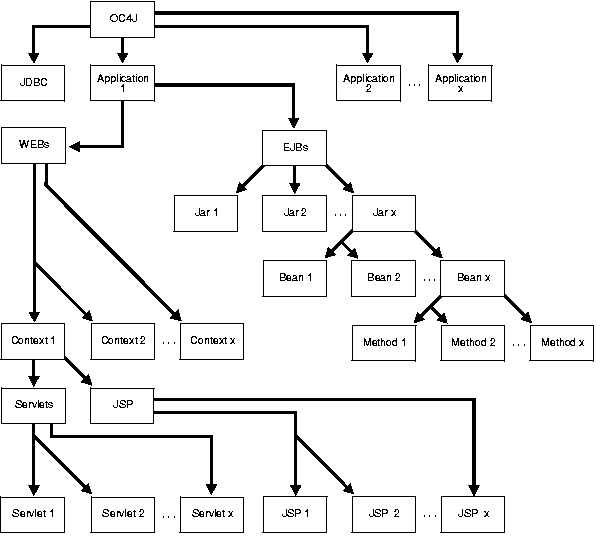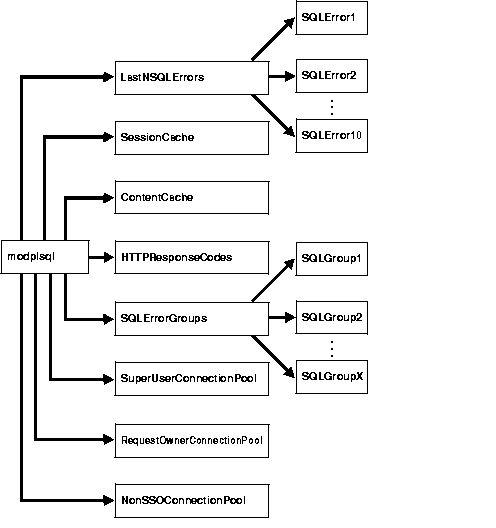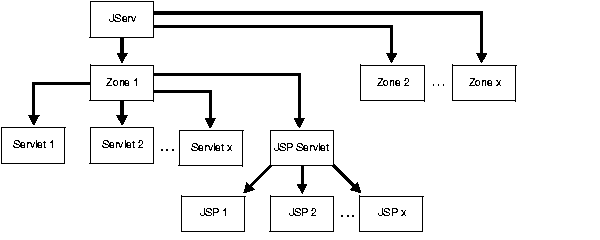Release 2 (9.0.2) for UNIX
Part Number A95102-01
Home |
Contents |
Index |
| Oracle9i Application Server Performance Guide Release 2 (9.0.2) for UNIX Part Number A95102-01 |
|
This appendix lists metrics that can help you analyze Oracle9iAS performance. The metrics fall into several distinct areas, such as Oracle HTTP Server, Oracle9iAS Containers for J2EE (OC4J), and Portal. Each table in this chapter lists the metrics that are included in a corresponding DMS metric table.
This appendix contains:
The tables, Table A-1,Table A-2, Table A-3 describe the Oracle HTTP Server metrics.
The metric table name is ohs_server.
| Metric | Description | Unit |
|---|---|---|
|
|
Number of loaded modules |
|
There is one set of metrics for each module loaded into the server.
The metric table name is ohs_module.
There is one set of metrics for each Java process (OC4J or Jserv) currently running in the site. The metric table name is JVM.
The following tables list the JDBC metrics collected in Oracle9iAS.
There is one set of JDBC Driver metrics per JVM. The metric table name is JDBC_Driver.
The metric table name is JDBC_DataSource.
There is one set of data source metrics per data source.
data-source-name - JDBC_Data Source Metrics
The metric table name is JDBC_Connection. There is one set of JDBC Connection metrics per connection.
CONNECTION - JDBC Driver Connection Metrics
The metric table name is JDBC_Connection. There is one set of JDBC data source specific connection metrics per data source per connection.
data-source-name/CONNECTION - JDBC Datasource Connection Metrics
The metric table name is JDBC_Statement.
There is a set of statement metrics per connection per statement.
CONNECTION/STATEMENT JDBC Statement Metrics
The metric table name is JDBC_Statement.
There is a set of statement metrics per data source per connection per statement.
data-source-name/CONNECTION/STATEMENT JDBC Statement Metrics
Figure A-1 illustrates the metrics in a J2EE application.

There is one set of metrics for each Web module within each J2EE application.
The metric table name is oc4j_web_module.
application/WEBs Metrics
There is one set of metrics for each Web context module within each J2EE application.
The metric table name is oc4j_context.
application/WEBs/context Metrics
There is one set of metrics for each servlet in each Web module within each J2EE application.
The metric table name is oc4j_servlet.
application/WEBs/context /SERVLETS/servlet Metrics
There is one set of metrics for each Web context for each J2EE application.
The metric table name is oc4j_jspExec.
application/WEBs/context /JSP Metrics
There is one set of metrics for each JSP in each Web module. the data for availableInstance.* appears only for non-threadsafe JSPs.
The metric table name is oc4j_jsp.
application/WEBs/context /JSPjsp_name Metrics
Oracle9iAS provides a set of these metrics for each type of bean in each EJB jar file in each J2EE application.
The metric table name is oc4j_ejb_entity_bean.
application/EJBs/ejb-jar-module/ejb-name Metrics
There is one set of metrics for each method within each type of EJB bean.
The metric table name is oc4j_ejb_method.
The client.* metrics show values for the actual implementation of the method. The wrapper.* metrics show values for the wrapper that was automatically generated for the method.
application/EJBs/ejb-jar-module/ejb-name/method-name Metrics
This section describes the Oracle9iAS Portal metrics.
Figure A-2, "mod_plsql Metric Tree" shows the structure of the mod_plsql metrics. The tables in this section describe the relevant metrics.

The /modplsql/HTTPResponseCodes Metrics lists the response codes returned by mod_plsql.
The metric table name is modplsql_HTTPResponseCodes. This metric table includes one metric containing the count, number of times the response was generated, for each HTTP response type.
[type=modplsql_HTTPResponseCodes]
For example, the http404.count metric holds a count of the "HTTP 404: Not found" response codes.
Table A-18 lists the set of metrics for the mod_plsql session cache.
The metric table name is modplsql_Cache.
Table A-19 lists the set of metrics for the mod_plsql content cache.
The metric table name is modplsql_ContentCache.
The SQLErrorGroups metrics show the predefined groupings of SQL errors. For each group, the metrics in Table A-20 are recorded.
The metric table name is modplsql_SQLErrorGroup:
/modplsql/SQLErrorGroups/group [type=modplsql_SQLErrorGroup]
The group is based on the groupings in the Oracle SQL error documentation. For example, the metric name Ora24280Ora29249 represents the grouping Ora-24280 to Ora-29249. Each SQL error that occurs as a result of executing a request is put into the appropriate group based on its error code. If you are getting a high number of the same errors, you should investigate what is causing the problem, using the Oracle SQL error message documentation for further details on the error message.
The LastNSQLErrors statistics show the last 10 SQL errors that have occurred while executing requests. These are updated in a round robin fashion. For each error, the metrics in Table A-21 are recorded.
The metric table name is modplsql_LastNSQLError:
/modplsql/LastNSQLErrors/<SQL Error Slot> [type=modplsql_LastNSQLError]
If you are getting a large number of the same errors, you should investigate what is causing the problem. Refer to the Oracle SQL error messages documentation for further details of the error represented by the errorText.value metric.
| Metric | Description | Unit |
|---|---|---|
|
|
Date the request caused the SQL error |
date |
|
|
Request causing the SQL error |
url |
|
|
SQL error text |
error |
Table A-22 lists the set of metrics for the Non-SSO connection pool.
The metric table name is modplsql_DatabaseConnectionPool:
/modplsql/NonSSOConnectionPool [type=modplsql_DatabaseConnectionPool]
Table A-23 lists the set of metrics for the request owner connection pool.
The metric table name is modplsql_DatabaseConnectionPool:
/modplsql/RequestOwnerConnectionPool [type=modplsql_DatabaseConnectionPool]
Table A-24 lists the set of metrics for the super user connection pool.
The metric table name is modplsql_DatabaseConnectionPool:
/modplsql/SuperUserConnectionPool [type=modplsql_DatabaseConnectionPool]
Figure A-3, "Parallel Page Engine Metric Tree" shows the structure of the Parallel Page Engine metrics. The tables in this section describe the relevant metrics.

The set of metrics can be broken down into static and dynamic types. Static metrics are those that are always available and dynamic being those metrics that only appear if a specific event occurs, such as when a specific portlet is requested. All of the PageEngine and ResponseCodes metrics are static, the remaining metrics are dynamic.
Table A-25 lists the set of metrics for the Parallel Page Engine. The metric table type is modplsql_PageEngine. This set represents the general performance of the Parallel Page Engine. If you intend to use the cache you should ensure that the cacheEnabled.value metric is set 1. To turn the cache on, refer to the mod_plsql cache and Parallel Page Engine configuration documentation.
The set of metrics for the response codes returned by internal requests, such as portlets, page, or metadata, made by the Parallel Page Engine are in the metric table is modplsql_PageEngine_ResponseCodes.
This table contains a count for each HTTP response type.
For example, http100.count, contains a count of the HTTP:100 Continue response codes.
In addition, the metric httpUnresolvedRedirect.value contains a count of requests that were not resolved after returning a redirect HTTP response code and httpTimeout.value contains a count of requests that timed out in the PPE internal request queue.
Table A-26 lists the set of metrics for the internal Parallel Page Engine page metadata requests. The metric table name is dynamic in that it includes the URL used to request the page metadata. If you are encountering a large number of failed requests, check the HTTPD error_log for details of why the requests are failing. The mod_plsql metrics may also provide further details.
url Metrics
Table A-27 lists the set of metrics for the internal Parallel Page Engine login metadata requests. The metric table name is dynamic in that it includes the URL used to request the login metadata. If you are encountering a large number of failed requests, check the HTTPD error_log for details of why the requests are failing. The mod_plsql metrics may also provide further details.
url Metrics
Table A-28 lists the set of metrics for the internal Parallel Page Engine Portal version requests. The metric table name is dynamic in that it includes the URL used to request the version of the Portal repository. If you are encountering a large number of failed requests, check the HTTPD error_log for details of why the requests are failing. The mod_plsql metrics may also provide further details.
url Metrics
Table A-29 lists the set of metrics for the internal Parallel Page Engine Portal XSL requests. The metric table name is dynamic in that it includes the URL used to request the XSL document. If you are encountering a large number of failed requests, check the HTTPD error_log for details of why the requests are failing. The mod_plsql metrics may also provide further details.
url Metrics
Table A-30 lists the set of metrics for the internal Parallel Page Engine PL/SQL provider requests, holding a metric summary of all the requested portlets owned by a specific provider. The metric table name is dynamic in that it includes the provider name. dad-provider indicates the name of the DAD that the named provider is registered and accessed through. If you are encountering a large number of failed requests, check the HTTPD error_log for details of why the requests are failing. The mod_plsql metrics may also provide further details.
dad-provider Metrics
Table A-31 lists the set of metrics for the internal Parallel Page Engine Portal PL/SQL portlet requests. The metric table name is dynamic in that it includes both the provider and portlet names. Table A-30 contains metrics summarizing all of the portlets requested that are owned by a specific PL/SQL provider.
If you are encountering a large number of failed requests, check the HTTPD error_log for details of why the requests are failing. The mod_plsql metrics may also provide further details.
dad-provider/portlet Metrics
Table A-32 lists the set of metrics for the internal Parallel Page Engine Web provider requests, holding a metric summary of all the requested portlets owned by a specific provider. The metric table name is dynamic in that it includes the provider name. If you are encountering a large number of failed requests, check the HTTPD error_log for details of why the requests are failing. The mod_plsql metrics may also provide further details.
dad-provider Metrics
Table A-33 lists the set of metrics for the internal Parallel Page Engine Portal Web portlet requests. The metric name is dynamic in that it includes both the provider and portlet names. Table A-32 contains metrics summarizing all of the portlets requested that are owned by a specific Web provider.
If you are encountering a large number of failed requests, check the HTTPD error_log for details of why the requests are failing. The mod_plsql metrics may also provide further details. If you are seeing a large number of HTTP redirects (302), consider coding the portlet to avoid the redirect as this helps performance. If you have coded you portlet to be cacheable and the number of cache hits is low, check the mod_plsql cache settings to ensure they are set to the appropriate levels for your system.
dad-provider/portlet Metrics
Figure A-4 shows the structure of the JServ metrics. The following tables describe the relevant metrics.

There is one set of metrics for each JServ server process.
The metric table name is jserv_server.
There is one set of metrics for each JServ zone.
The metric table name is jserv_zone.
zone Metrics
There is one set of metrics per servlet. Note that the JSP servlet holds all of the aggregated load metrics for all servlets and JSPs within a zone.
The metric table name is jserv_servlet.
zone/servlet Metrics
There is one set of metrics per JSP. Note that the JSP servlet holds all of the aggregated load metrics for all servlets and JSPs within a zone.
The metric table name is jserv_jsp.
zone/servlet Metrics
|
|
 Copyright © 2002 Oracle Corporation. All Rights Reserved. |
|